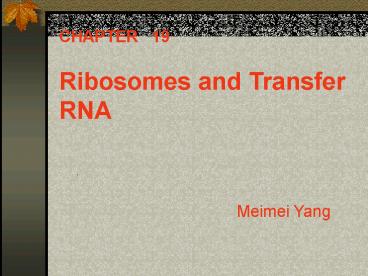Ribosomes and Transfer RNA - PowerPoint PPT Presentation
1 / 36
Title:
Ribosomes and Transfer RNA
Description:
In the 1970s, James Lake used negative staining techniques to produce ... These structures have amply verified Fersht's elegant hypothesis. Summary. Ribosome ... – PowerPoint PPT presentation
Number of Views:200
Avg rating:3.0/5.0
Title: Ribosomes and Transfer RNA
1
CHAPTER 19 Ribosomes and Transfer RNA
Meimei Yang
2
Outline
19.1 Ribosomes
19.2 Transfer RNA
3
19.1 Ribosomes
- Gross Structure
- Composition
- Assembly
4
Gross Structure
In the 1970s, James Lake used negative staining
techniques to produce electron micrographs.
Place the sample on a microscope grid
Add a solution of a heavy metal salt
Allow the grid to dry
Observe
Take pictures
5
Electron micrographs of 30S ribosomal subunits
6
Model of the E.coli 30S ribosomal subunit in two
7
Electron micrographs of 50S ribosomal subunits
8
Model of the E.coli 50S ribosomal subunit in two
9
Electron micrographs of E.coli 70S ribosomes in
two
10
To get a fine structure of the 70S ribosome,
x-ray crystallography provides the best
information.
11
Composition
16S RNA
30S subunit
21 ribosomal proteins
23S RNA
50S subunit
5S RNA
34 ribosomal proteins
12
rRNA analysis
Remove the proteins by phenol extracting ribosomes
Leave rRNA in solution
Ultracentrifugation determine the sizes of the
rRNAs
13
Protein analysis
In 1970, E.Kaldschmidt and H.G.
Wittmann used two-dimensional gel electrophoresis
to give almost complete resolution of the
ribosomal proteins from both subunits.
14
Two-dimensional gel electrophoresis of proteins
from E.coli 30S subunits
15
Two-dimensional gel electrophoresis of proteins
from E.coli 50S subunits
16
Assembly
Nomura and colleagues radioactively
labeled all the proteins, then added each,
separately, to 16S rRNA and measured its binding
by scintillation counting.
17
Effects of 30S ribosomal proteins on S12 binding
to 16S rRNA
18
Assembly map of E.coli 30S ribosomal subunit
19
19.2 Transfer RNA
- Discovery
- Structure
- Aminoacyl-tRNA Synthetase
20
Discovery
By 1957, Zamecnik and colleagues had worked out
a cell-free protein system. pH 5 enzyme
fraction worked with ribosomes to direct
translation of added mRNAs. Most were
proteins, but they discovered a small RNA that
could be coupled to amino acids.
21
Discovery of tRNA
22
Structure
In 1969, 14 tRNA sequences had been
determined, and it became clear that, despite
considerable differences in primary structure,
all could assume essentially the same
cloverleaf secondary structure.
23
Two views of the cloverleaf structure of tRNA
24
In the 1970s, Alexander Rich and colleagues
used X-ray diffraction techniques to reveal the
tertiary structure of tRNAs.
25
Stereo view of tRNA
26
Aminoacyl-tRNA Synthetase
- Importance
- Recognition of tRNAs
- Proofreading and Editing
27
- Importance
In 1962, Fritz Lipmann, Seymour Benzer, Gunter
von Ehrenstein, and colleagues demonstrated that
the ribosome recognizes the tRNA, not the amino
acid, in an aminoacyl-tRNA.
Form cysteinyl-tRNACys
Reduce the cysteine with Raney nickel to yield
alanyl-tRNACys
28
The ribosome responds to the tRNA, not the amino
acid of an aminoacyl-tRNA
29
Add this altered aminoacyl-tRNA to a translation
system
Include mRNAs that encode cysteine
cause incorporation of alanine
Show ribosomes do not discriminate
amino acid attached to tRNA, pointed to the
importance of fidelity in the aminoacly-tRNA
synthetase step
30
Recognition of tRNAs
X-ray crystallography studies of
complexes between tRNAs and their cognate
aminoacyl-tRNA synthetase have shown that both
the acceptor stem and the anticodon have docking
sites on the synthetase.
31
Three-dimensional structure of glutaminyl-tRNA
synthetase complexed with tRNA and ATP
32
Proofreading and Editing
As good as aminoacyl-tRNA synthetases
are recognizing the correct (cognate) tRNAs, they
have a more difficult job recognizing the cognate
amino acids.
33
Proposed by Alan Fersht in 1977, the
enzyme uses a double-sieve mechanism to avoid
producing tRNAs with the wrong amino acid
attached.
34
Shigeyuki Yokoyama and colleagues have
obtained the crystal structure of the Thermnus
thermophilus IleRS alone. Coupled to its
cognate amino acid, and to the noncognate amino
acid valine. These structures have amply
verified Fershts elegant hypothesis.
35
Summary
Ribosome
Structure
Composition
Assembly
tRNA
Discovery
Structure
Aminoacyl-tRNA
36
Thank you!































